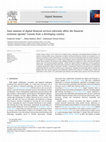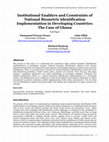Papers by EMMANUEL KWAME OWUSU-OWARE

Journal of Business and Professional Studies, 2024
The scare of the COVID-19 pandemic in the early stages and subsequent lockdowns by countries worl... more The scare of the COVID-19 pandemic in the early stages and subsequent lockdowns by countries worldwide caused many business organisations to shut down their operations. To mitigate the effects of the ensuing socioeconomic hardships, businesses resorted to work-from-home and online digital interactions. However, as economic activities migrated online, criminals followed suit. This study employs qualitative research methodology and the combined theories of rational choice and general deterrence to explore the relationship between online activities during COVID-19 and cybercrime. The findings from this study show that COVID-19 norms increased and deepened the social circumstances that cybercriminals exploit to engage in their nefarious acts. These circumstances include stay-at-home, charity, global attention, known authorities, urgency, system vulnerabilities, lack of cybersecurity awareness training, and lack of qualified cybersecurity professionals. The study has implications for cybersecurity practices for business organisations and research.

Journal of Information Technology Case and Application Research
Transportation by sea routes and seaport container terminals are critical infrastructure that fac... more Transportation by sea routes and seaport container terminals are critical infrastructure that facilitates global trade. Thus, the emerging information systems research on smart container systems is essential. However, these studies lack empirical insights, and there is little on developing country contexts. To address these knowledge gaps, this study employs qualitative interpretive case study approach and technology affordance and constraint theory to investigate how Ghana’s port authority replaced a predominantly paper-based container handling system with smart systems, as well as the consequences of doing so. The study’s findings show that technology affordances are actualized in a developing country seaport smart container system based on management’s perception of the system and the port’s situational context. The study’s findings show significant improvements over the manual paper processes, along with constraints including stakeholder digital unpreparedness, limited data storage capacity, unreliable internet and power supply disruptions, and equipment breakdowns. The findings have implications for research, practice, and policy.

Digital Business, 2023
Despite strong evidence of the critical role of mobile money technology in deepening financial in... more Despite strong evidence of the critical role of mobile money technology in deepening financial inclusion, the impact of taxing mobile money transactions on digital and financial inclusion remains an unexplored area of research. By drawing on the Unified Theory of Acceptance and Use of Technology model, this research presents a
rich insight into the determinants of mobile money adoption and the moderating effect of taxation (e-levy) on mobile money adoption. The purposive data sampling technique was employed to collect data from 287 mobile money users. The structural equation modeling – partial least square method was applied to test the hypotheses
of this study. The findings show that performance expectancy, effort expectancy, social influence, and facilitating conditions significantly influence behavioral intention. Consequently, behavioral intention shows a significant relationship with the actual use of mobile money. Furthermore, regarding the moderating effect of taxation, the
findings show that taxation negatively and significantly influences the actual use of mobile money. Finally, the implications of the results to tax policymakers (government) and mobile money operators have been discussed.

Journal of Information Technology Case and Application Research, 2023
Transportation by sea routes and seaport container terminals are critical infrastructure that fac... more Transportation by sea routes and seaport container terminals are critical infrastructure that facilitates global trade. Thus, the emerging information systems research on smart container systems is essential. However, these studies lack empirical insights, and there is little on developing country contexts. To address these knowledge gaps, this study employs qualitative interpretive case study approach and technology affordance and constraint theory to investigate how Ghana’s port authority replaced a predominantly paper-based container handling system with smart systems, as well as the consequences of doing so. The study’s findings show that technology affordances are actualized in a developing country seaport smart container system based on management’s perception of the system and the port’s situational context. The study’s findings show significant improvements over the manual paper processes, along with constraints including stakeholder digital unpreparedness, limited data storage capacity, unreliable internet and power supply disruptions, and equipment breakdowns. The findings have implications for research, practice, and policy.

Education and Information Technologies
With the advent of smartphones and fourth generation mobile technologies, the effect of social me... more With the advent of smartphones and fourth generation mobile technologies, the effect of social media on society has stirred up some debate and researchers across various disciplines have drawn different conclusions. Social media provides university students with a convenient platform to create and share educational content. However, social media may have an addicting effect that may lead to poor health, poor concentration in class, poor time management and consequently poor academic performance. Using a random sample of 623 students from the University of Professional Studies Accra, Ghana, this paper presents a social media influence factor (SMIF) model for measuring the effect of social media on student academic performance. The proposed model is examined using linear regression analysis and the results show a statistically significant negative relationship between SMIF variables and student grade point average (GPA). The model accounted for 30.7% of the variability in student GPA and it demonstrated a prediction quality of 55.4% given the data collected.

Information Development, 2022
The conception of biometric systems as a means of securing sensitive information and enhancing se... more The conception of biometric systems as a means of securing sensitive information and enhancing service delivery remains under-researched. To address this knowledge gap, we explore the case of a public-sector social security and pension organisation in Ghana using a qualitative interpretative study approach and the information security model of confidentiality-integrity-availability as an analytical lens. The study's findings indicate that integrating and using biometric identification and authentication as part of delivering social security and pension services can protect availability, confidentiality, and integrity of information. The findings further show that the use of a biometric system for social security and pension information security can contribute to reducing service turnaround time and vulnerability to fraudulent manipulation of benefits payments. The study provides implications for research, practice, and policy. For research, the paper opens up biometric systems’ ...

International Journal on Integrating Technology in Education, 2020
The objectives of the study were to show the basic differences between Distance, Blended and Onli... more The objectives of the study were to show the basic differences between Distance, Blended and Online learning, and establish their common challenges from literature. Approximately 35 categories/sets of research results or findings from more than 65 publications were reviewed and used for this work. Articles were obtained from sources such as Google Scholar, ResearchGate, Academia.edu, Google Search Engine, and Elsevier. The key themes used for the search are Distance education, Distance learning, Online learning, Blended learning, Differences between face-to-face and online learning, and the use of the internet for learning. The differences between Distance, Blended, and Online Learning (DBOL) modes were summarized, and 11 challenges of DBOL were realized. These 11 challenges were summarized into six themes namely, lack of infrastructure, low or no IT skills, self-disciplinary problems, content issues, policy issues, and social issues. It was strongly advised that, for effective DBOL...

Journal of Contemporary Issues in Business and Government, 2023
Learning management systems in higher education contexts attained significance in digital innovat... more Learning management systems in higher education contexts attained significance in digital innovations during the COVID-19 pandemic when many universities switched suddenly to online mode of teaching and learning. While many universities continue to use learning management systems to supplement face-to-face teaching and learning, academics are concerned about the efficacy and integrity of the online examination environment. This study uses empirical survey data to investigate the case of a developing country university in Ghana that has been using Moodle learning management system for online assessments since 2019 to supplement in-person assessments. The study examined the university's teachers' use of learning management system tools for assessments, their perceptions of the effectiveness/integrity of these tools for examinations, and the challenges involved. This paper presents the results of the study.

THE ELECTRONIC JOURNAL OF INFORMATION SYSTEMS IN DEVELOPING COUNTRIES
The COVID-19 pandemic outbreak and the subsequent lockdowns and restrictions by many countries wo... more The COVID-19 pandemic outbreak and the subsequent lockdowns and restrictions by many countries worldwide to control the spread of the virus forced several organizations to shift work to homes, aided by digital technologies. However, digital infrastructure and homeworking space, which facilitate home-based e-working, are constrained in the developing world. It is, therefore, crucial to understand how developing country organizations maintain business operations under pandemic situations using home-based e-working and the challenges it poses. This study employs interpretive qualitative research methodology with a socio-technical perspective to explore home-based e-working under COVID-19 conditions using five reputable corporate organizations in Ghana. Findings from the study show that home-based e-working under pandemic conditions can be seen as a business continuity strategy that requires business continuity policy and plan, digital infrastructure and platforms, and cybersecurity. The findings also identified the challenges as partial work virtualization, cybercrime, transition cost, digital divide, and home environment constraints. The findings have implications for research and organizational management in developing countries.

Electronic Journal of Information Systems in Developing Countries, 2022
The COVID-19 pandemic outbreak and the subsequent lockdowns and restrictions by many countries wo... more The COVID-19 pandemic outbreak and the subsequent lockdowns and restrictions by many countries worldwide to control the spread of the virus forced several organizations to shift work to homes, aided by digital technologies. However, digital infrastructure and homeworking space, which facilitate home-based e-working, are constrained in the developing world. It is, therefore, crucial to understand how developing country organizations maintain business operations under pandemic situations using home-based e-working and the challenges it poses. This study employs interpretive qualitative research methodology with a socio-technical perspective to explore home-based e-working under COVID-19 conditions using five reputable corporate organizations in Ghana. Findings from the study show that home-based e-working under pandemic conditions can be seen as a business continuity strategy that requires business continuity policy and plan, digital infrastructure and platforms, and cybersecurity. The findings also identified the challenges as partial work virtualization, cybercrime, transition cost, digital divide, and home environment constraints. The findings have implications for research and organizational management in developing countries.

The purpose of this study is to understand how institutions shape national biometric identificati... more The purpose of this study is to understand how institutions shape national biometric identification implementation in developing countries. National biometric identification initiatives have become important because they are being used by governments in developing countries to support socio-economic development. There is a growing body of research on national biometric identification systems but many lack theoretical grounding to better inform policy, practice and research. Given this gap, this paper employs a qualitative interpretive case study methodology to investigate regulative, normative and cognitive institutional effects on a national biometric identification implementation in a developing country. The findings show how a confluence of some local regulative and cognitive institutions as well as international normative institution enabled implementation while others constrained it. The net effect was the identification initiative becoming stalled. The findings have implicatio...

The purpose of this study is to understand how developing countries can deploy biometric technolo... more The purpose of this study is to understand how developing countries can deploy biometric technology to fight fraud in national health insurance. Information systems research has discussed the use and impact of ICTs in fighting corruption. However, little is known about biometric technology and national health insurance fraud. To fill this knowledge gap, this paper draws on interpretive case study methodology and sociomateriality theory to investigate Ghana’s experience in using biometric technology to fight national health insurance fraud. The findings show that health insurance fraud can be reduced by employing an integrated solution of social and technical systems comprising: 1) online biometric enrollment of members and verification at the point of health service delivery; 2) use of complementary technologies such as eclaims and 3) operational policies such as the use of clinicians in vetting service providers’ claims.

Information Technology for Development, 2020
ABSTRACT Biometric systems offer opportunities for developing countries to address citizen identi... more ABSTRACT Biometric systems offer opportunities for developing countries to address citizen identification challenges. In recent years, biometric systems have been deployed at the national and sector levels or both. However, related information systems research has focused on either the national or sector levels. Less knowledge thus exists on the relationship between the two levels. To address this gap, this study employs interpretive case study methodology and activity theory to investigate a failed national biometric project in Ghana and its relationship with emergent sector level biometric systems. The findings show that lack of political consensus and conflicting laws can lead to national biometric system failure and multiple sector level systems. Moreover, implementation of multiple biometric systems leads to duplication of resources, infrastructure, and biometric data for individuals. Based on the findings, the paper discusses implications for theory, research, and national development.
Information Systems Management, 2020
This paper draws on interpretive case study methodology and e-government enactment framework to u... more This paper draws on interpretive case study methodology and e-government enactment framework to understand Ghana's biometric identification initiative implementation and its failure to achieve the intended socioeconomic development impacts. To better understand how such initiatives can be deployed to achieve the desired impacts, the findings on the reasons for the failed Ghana's case are compared with that of a successful developing country's case. The study offers contributions to research, policy and practice.

The purpose of this study is to understand how institutions shape national biometric identificati... more The purpose of this study is to understand how institutions shape national biometric identification implementation in developing countries. National biometric identification initiatives have become important because they are being used by governments in developing countries to support socioeconomic development. There is a growing body of research on national biometric identification systems but many lack theoretical grounding to better inform policy, practice and research. Given this gap, this paper employs a qualitative interpretive case study methodology to investigate regulative, normative and cognitive institutional effects on a national biometric identification implementation in a developing country. The findings show how a confluence of some local regulative and cognitive institutions as well as international normative institution enabled implementation while others constrained it. The net effect was the identification initiative becoming stalled. The findings have implication for policy, practice and research.









Uploads
Papers by EMMANUEL KWAME OWUSU-OWARE
rich insight into the determinants of mobile money adoption and the moderating effect of taxation (e-levy) on mobile money adoption. The purposive data sampling technique was employed to collect data from 287 mobile money users. The structural equation modeling – partial least square method was applied to test the hypotheses
of this study. The findings show that performance expectancy, effort expectancy, social influence, and facilitating conditions significantly influence behavioral intention. Consequently, behavioral intention shows a significant relationship with the actual use of mobile money. Furthermore, regarding the moderating effect of taxation, the
findings show that taxation negatively and significantly influences the actual use of mobile money. Finally, the implications of the results to tax policymakers (government) and mobile money operators have been discussed.
rich insight into the determinants of mobile money adoption and the moderating effect of taxation (e-levy) on mobile money adoption. The purposive data sampling technique was employed to collect data from 287 mobile money users. The structural equation modeling – partial least square method was applied to test the hypotheses
of this study. The findings show that performance expectancy, effort expectancy, social influence, and facilitating conditions significantly influence behavioral intention. Consequently, behavioral intention shows a significant relationship with the actual use of mobile money. Furthermore, regarding the moderating effect of taxation, the
findings show that taxation negatively and significantly influences the actual use of mobile money. Finally, the implications of the results to tax policymakers (government) and mobile money operators have been discussed.